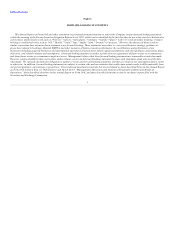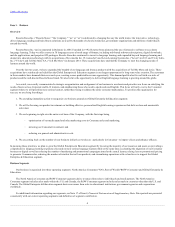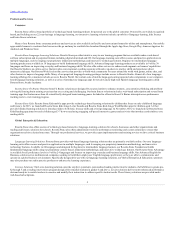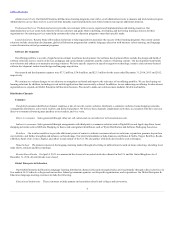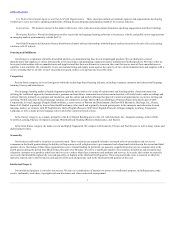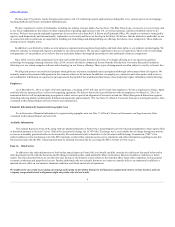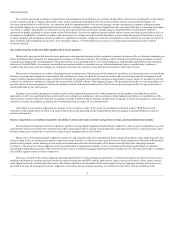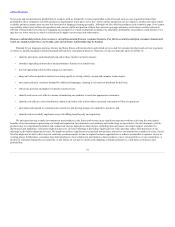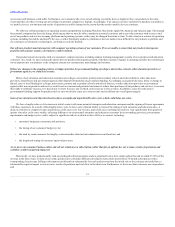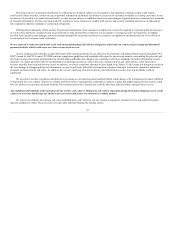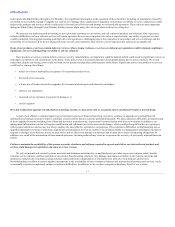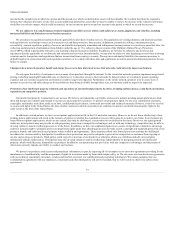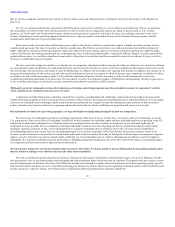Rosetta Stone 2014 Annual Report Download - page 12
Download and view the complete annual report
Please find page 12 of the 2014 Rosetta Stone annual report below. You can navigate through the pages in the report by either clicking on the pages listed below, or by using the keyword search tool below to find specific information within the annual report.
Table of Contents
If the recognition by schools and other organizations of the value of technology-based education does not continue to grow, our ability to generate revenue
from organizations could be impaired.
Our success depends in part upon the continued adoption by organizations and potential customers of technology-based education initiatives. Some
academics and educators oppose online education in principle and have expressed concerns regarding the perceived loss of control over the education
process that could result from offering courses online. If the acceptance of technology-based education does not continue to grow, our ability to continue to
grow our Global Enterprise & Education business could be impaired.
We depend on discretionary consumer spending in the consumer segment of our business. Adverse trends in general economic conditions, including retail
and online shopping patterns or consumer confidence, as well as other external consumer dynamics may compromise our ability to generate revenue.
The success of our business depends to a significant extent upon discretionary consumer spending, which is subject to a number of factors, including
general economic conditions, consumer confidence, employment levels, business conditions, interest rates, availability of credit, inflation and taxation.
Adverse trends in any of these economic indicators may cause consumer spending to decline further, which could hurt our sales and profitability.
Because a significant portion of our consumer sales are made to or through retailers and distributors, none of which has any obligation to sell our
products, the failure or inability of these parties to sell our products effectively could hurt our revenue and profitability.
We rely on retailers and distributors, together with our direct sales force, to sell our products. Our sales to retailers and distributors are highly
concentrated on a small group that comprises a mix of websites, such as Digital River and Apple iTunes App Store, select retail resellers such as Amazon.com,
Barnes & Noble, Target, Best Buy, Books-a-Million, Staples, Sam's Club, and Costco, daily deal partners such as Groupon, home shopping networks such as
GS Home Shopping in Korea, and consignment distributors such as Wynit Distribution and Software Packaging Associates. Sales to or through our retailers
and distributors accounted for approximately 13% of our revenue for the year ended December 31, 2014, compared to 18% for the year ended December 31,
2013.
We have no control over the amount of products that these retailers and distributors purchase from us or sell on our behalf, we do not have long-term
contracts with any of them, and they have no obligation to offer or sell our products or to give us any particular shelf space or product placement within their
stores. Thus, there is no guarantee that this source of revenue will continue at the same level as it has in the past or that these retailers and distributors will not
promote competitors' products over our products or enter into exclusive relationships with competitors. Any material adverse change in the principal
commercial terms, material decrease in the volume of sales generated by our larger retailers or distributors or major disruption or termination of a relationship
with these retailers and distributors could result in a significant decline in our revenue and profitability. Furthermore, product display locations and
promotional activities that retailers undertake can affect the sales of our products. The fact that we also sell our products directly could cause retailers or
distributors to reduce their efforts to promote our products or stop selling our products altogether.
Many traditional physical retailers are experiencing diminished foot traffic and sales. For our retail business, even though online sales have increased
in popularity and are growing in importance, we continue to depend on sales that take place in physical stores and shopping malls. Reduced customer foot
traffic in these stores and malls is likely to reduce their sales of our products. In addition, if one or more of these retailers or distributors are unable to meet
their obligations with respect to accounts payable to us, we could be forced to write off such accounts. Any bankruptcy, liquidation, insolvency or other
failure of any of these retailers or distributors could result in significant financial loss and cause us to lose revenue in future periods.
Price reductions and other concessions could reduce our revenue.
We continue to test and offer changes to the pricing of our products. If we reduce our prices in an effort to increase our sales, this could have an adverse
impact on our revenues to the extent that unit sales do not increase in a sufficient amount to compensate for the lower pricing. Reducing our pricing to
individual consumers could also cause us to have to lower pricing to our Global Enterprise and Education customers. Any increase in the taxation of online
sales could have the effect of a price increase to consumers and could cause us to have to lower our prices or could cause sales to decline. It is uncertain
whether we will need to continue to lower prices to effectively compete and what the other short and long-term impacts could be.
We also may provide our retailers and distributors with price protection on existing inventories, which would allow these retailers and distributors a
credit against amounts owed with respect to unsold packaged product under certain conditions. These price protection reserves could be material in future
periods.
11




